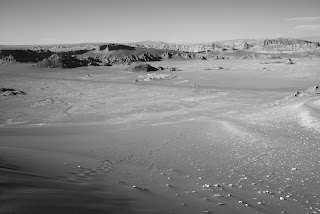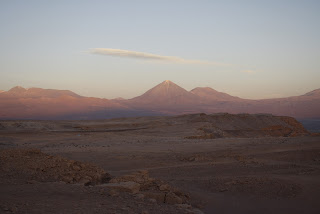24 Stunden (am Stück) nördlich von Santiago, an der Grenze zu Bolivien, liegt das Touristenörtchen San Pedro de Atacama. Am Rande der Wüste gelegen, ist es der Ausgangspunkt zu Ausflügen in eine eigenartige Landschaft geprägt von Wüste, Salzstein, Mineralien und Geysiren. Obwohl die Temperatur hier nicht viel mehr als 24 Grad erreicht, gilt diese Wüste als eine trockensten der Welt. Nachts fällt das Thermometer oft auf 0 Grad.
24 hours (non stop) north of Santiago near the Bolivian Border lies the touristtrap of San Pedro de Atacama. Settled at the edge of the desert it is the perfect starting point for excursions to the bizarre landscape of sanddunes, saltrocks, minerals and geysirs. Altough usually temperature's not rising higher than 24 degrees this desert is one of the driest in the world. In the night though it falls to 0 degrees.
Valle de la luna
Wir machten eine Tour ins Valle de la luna (Mondtal), das seinen Namen wegen seiner kuriosen Steinformationen in der Wüste trägt, die an eine Mondlandschaft erinnern. Das Tal wird umrahmt von meterhohen Felswänden und am Horizont schimmern die bolivianischen Berge. Ein Vulkan steht wie zufällig davor..
Valle de la luna
We went on a tour to the Valle de la luna (moon valley) which is called so because of its bizarre stone formations in the desert that remind of the landscape on the moon. The valley is framed by high cliffs and on the horizon you can see the Bolivian mountain range. A vulcano's accidentally placed in front of it.
Sternenhimmel
Der Himmel über der Atacamawüste eignet sich wegen ihrer vielen klaren Nächte und der geringen Lichtverschmutzung sehr gut, um Sterne zu beobachten. Dies tut der französische Astronome Alain seit 30 Jahren. Er bietet nächtliche Führungen in seinem Garten mit 9 grossen Teleskopen an. Mit einem Laserpointer haben er und seine Frau uns den chilenischen Sternenhimmel erklärt. Wir haben viel über Sterne, Planeten und Galaxien gelernt und sogar Boris' Sternzeichen am Himmel entdeckt. Das Foto unten wurde übrigens mit unserer Kamera aufgenommen mit einer Belichtungszeit von 30 Sekunden. Wir koennen nicht genau sagen, was man sieht, sicher ist die Milchstrasse drauf! :-)
Stargazing
The sky above the Atacama desert is one of the best to do stargazing because of the mostly clear nights and the low level of light pollution. French astronomer Alain is observing the sky since 30 years. He offers nightly tours in his garden where there are 9 big telescopes ready to use. He and his wife explained us the sky with their laserpointers. We learned a lot about stars, planets and galaxies. We even discovered Boris' starsign altough by now it is clear to us that the stars billions of light years away have little to do with our daily life. By the way the picture below was taken with our (new) camera with an exposure time of 30 seconds. We can't really tell what you can see on it, but there's the milky way for sure! :-)













Keine Kommentare:
Kommentar veröffentlichen